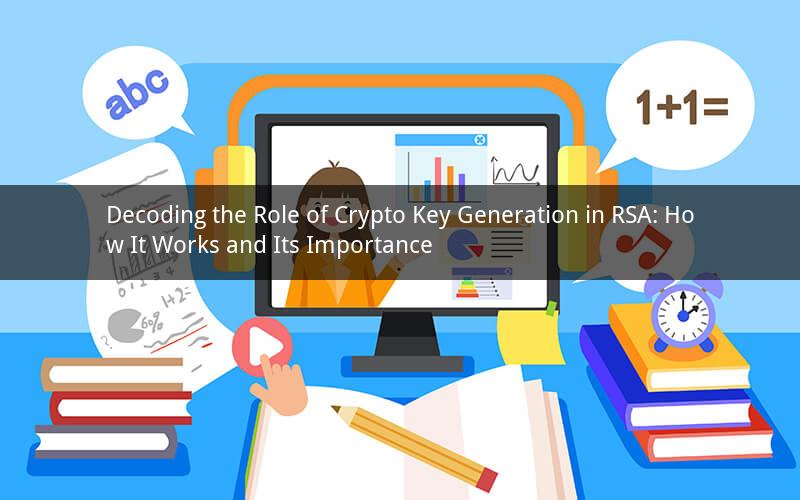
In the ever-evolving digital landscape, cryptography plays a pivotal role in securing sensitive information. One of the most widely used cryptographic algorithms is RSA, which heavily relies on the generation of crypto keys. This article delves into the intricacies of crypto key generation in RSA, explaining its significance and the process behind it.
What does crypto key generation in RSA do?
At its core, crypto key generation in RSA is the process of creating a pair of keys: a public key and a private key. These keys are essential for both encryption and decryption processes, ensuring secure communication between parties. Here's a breakdown of what each key does:
1. Public key: The public key is used for encryption purposes. It is shared with others and can be freely distributed without compromising the security of the encrypted data. When someone wants to send a secure message to you, they will use your public key to encrypt the message.
2. Private key: The private key is used for decryption purposes. It should be kept confidential and is used only by the intended recipient to decrypt the encrypted messages. If the private key falls into the wrong hands, the security of the encrypted data is compromised.
How does crypto key generation in RSA work?
The RSA algorithm is based on the mathematical properties of prime numbers. The process of generating crypto keys in RSA involves the following steps:
1. Choose two large prime numbers, p and q: The security of RSA relies on the difficulty of factoring large prime numbers. Choose two prime numbers, p and q, with a length of at least 2048 bits for optimal security.
2. Calculate n: Multiply the two prime numbers together to get n (n = p q). This value will be used in both the public and private keys.
3. Calculate φ(n): Compute the totient of n, which is the number of positive integers less than n that are coprime to n. For prime numbers p and q, φ(n) = (p-1) (q-1).
4. Choose an encryption exponent e: Select a value for e that is relatively prime to φ(n) and greater than 1. Common choices for e are 65537 and 32771.
5. Calculate the decryption exponent d: Find the modular multiplicative inverse of e with respect to φ(n), which is the value of d. This can be done using the Extended Euclidean algorithm.
6. Generate the public and private keys: The public key is (n, e), and the private key is (n, d).
What is the importance of crypto key generation in RSA?
The generation of crypto keys in RSA is crucial for several reasons:
1. Security: The security of RSA relies on the fact that it is computationally infeasible to factorize large prime numbers. A strong crypto key generation process ensures that the private key remains secure and cannot be easily obtained by unauthorized parties.
2. Authentication: The use of public and private keys in RSA allows for secure authentication. When a party encrypts a message using the recipient's public key, only the recipient with the corresponding private key can decrypt it, ensuring that the message is sent to the intended recipient.
3. Confidentiality: RSA encryption ensures that the content of the message remains confidential during transmission. By encrypting the message using the recipient's public key, only the recipient can decrypt and read the message.
4. Integrity: RSA provides a way to verify the integrity of the message. By using a hash function and digital signatures, the recipient can ensure that the message has not been tampered with during transmission.
5. Efficiency: The RSA algorithm is efficient for both encryption and decryption processes, making it suitable for secure communication over the internet.
Frequently Asked Questions (FAQs)
1. How long should the prime numbers used in RSA key generation be?
A: The length of the prime numbers should be at least 2048 bits for optimal security. As computing power increases, longer prime numbers may be required to maintain security.
2. Can the same prime numbers be used for both the public and private keys in RSA?
A: No, the same prime numbers cannot be used for both keys. The security of RSA relies on the fact that the two prime numbers are kept secret and used separately in the generation of public and private keys.
3. What is the significance of the encryption exponent e in RSA?
A: The encryption exponent e is used to encrypt messages using the public key. It should be chosen to be relatively prime to φ(n) and greater than 1. Common choices for e are 65537 and 32771.
4. How can I ensure the security of my RSA private key?
A: To ensure the security of your RSA private key, keep it confidential and store it in a secure location, such as a hardware security module (HSM) or a secure vault. Use strong password protection and limit access to the private key.
5. Can RSA encryption be broken?
A: While RSA encryption is considered secure for practical purposes, it is theoretically possible to break RSA encryption by factoring the large prime numbers used in the key generation process. However, this is computationally infeasible with current technology.